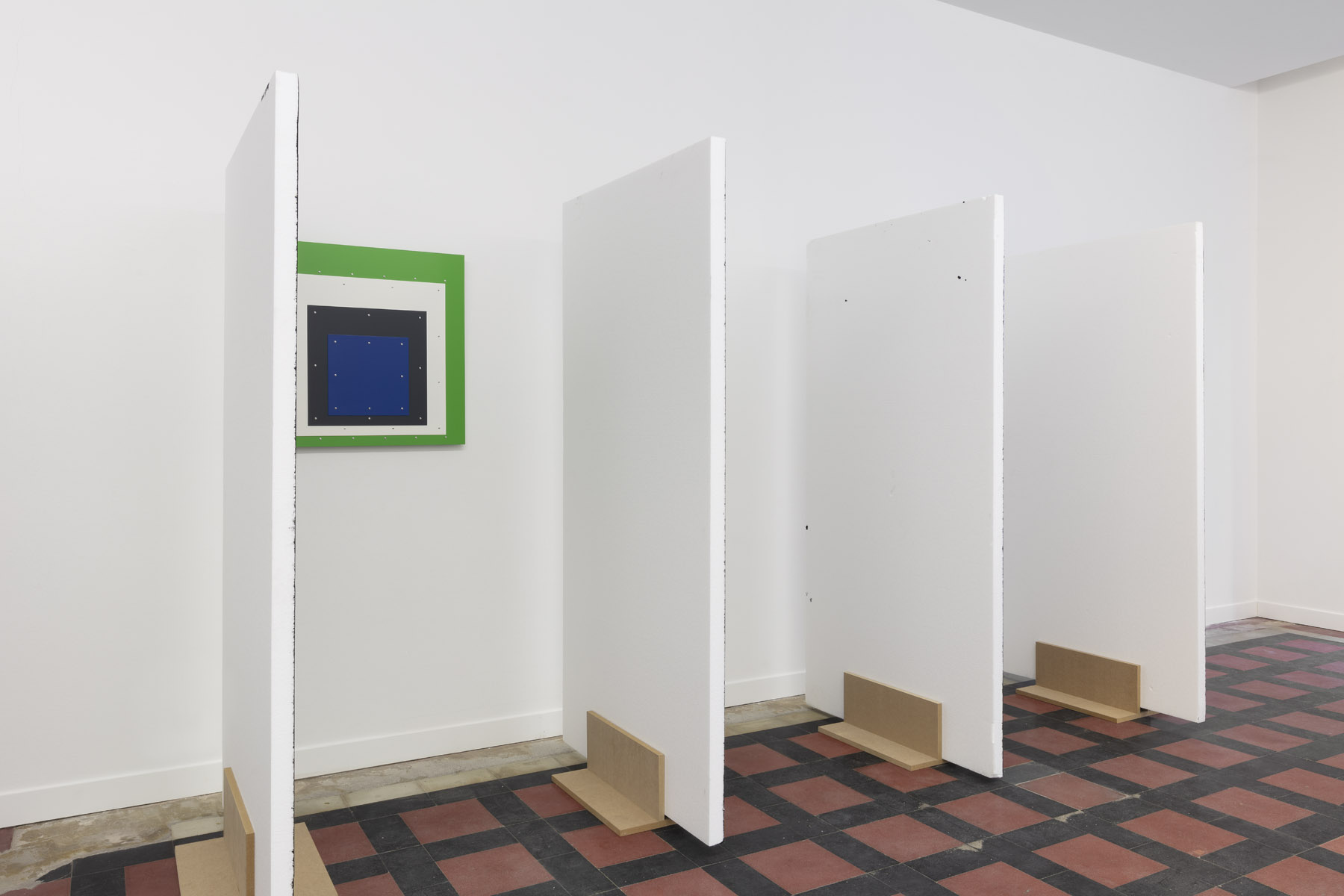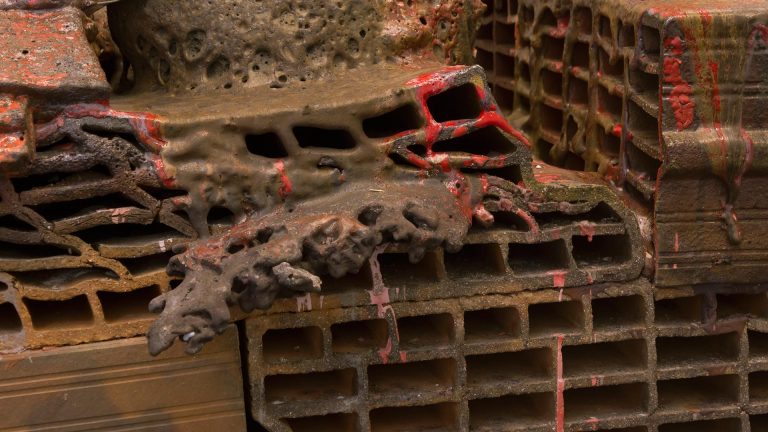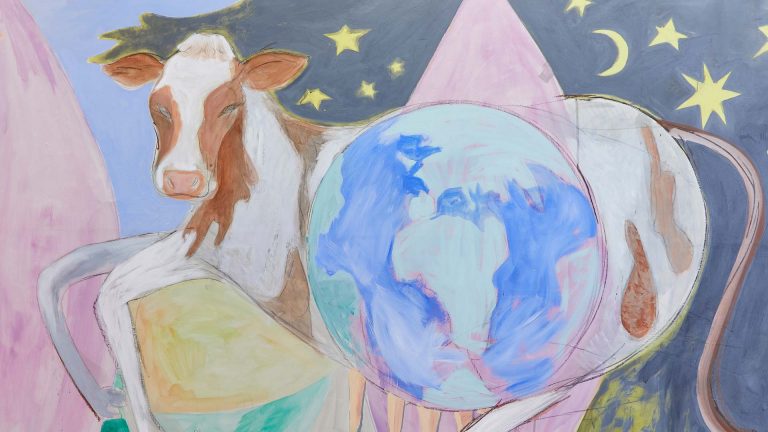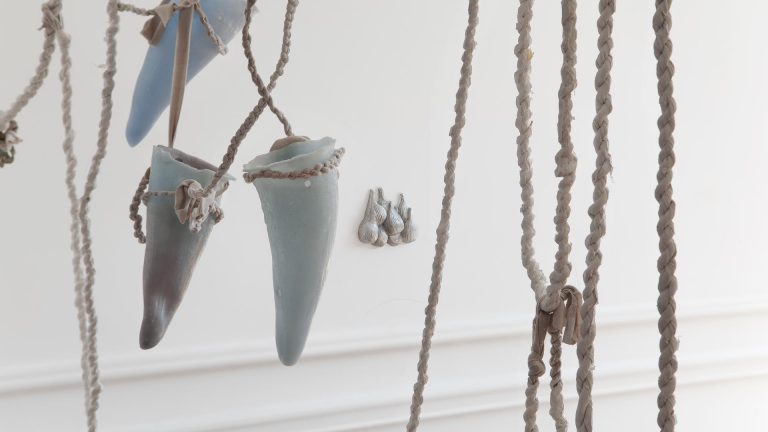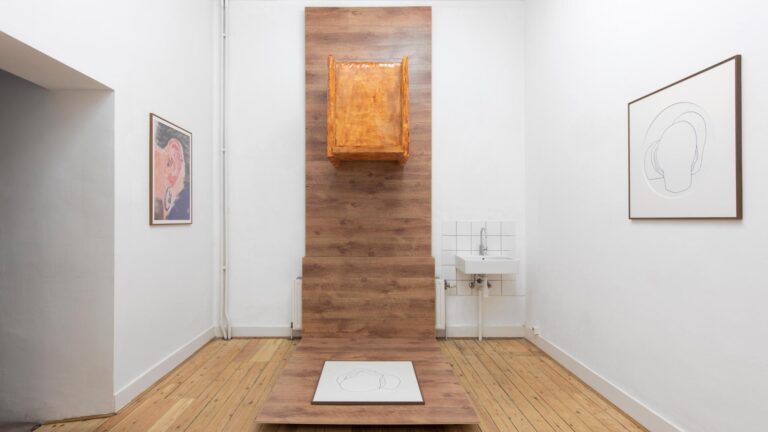Artist: Emanuele Marcuccio
Exhibition title: Sì o No
Venue: Damien & The Love Guru, Brussels hosted by CFA Live, Milan
Date: December 17, 2020 – February 2, 2021
Photography: © Andrea Rossetti / courtesy of the artist and Damien & The Love Guru
Note: Press release is available here
Emanuele Marcuccio: reproduction in an age of creative precarity
Emanuele Marcuccio’s (b. 1987, Italy) practice revolves around principles of reproduction and efficiency, challenging notions of authorship in art making through materials and processes from the world and imaginary of industry. He infiltrates the processes of industrial (re)production not only as an allusion to his hometown in the industrial region of Veneto, but also as a way to do away with the myth of the artist as creator. He tends to leave part of the production process out of his hands. This is particularly the case with the perforated steel panels which are a recurrent element in his practice and that he commissions to factories who perforate and paint them based on his initial design. The result is a chain-made product that becomes a sort of ersatz canvas when hung on a gallery wall. The principles of efficiency and productiveness related to factory work allow the artist to distance himself from the end product of the fabrication process. For him, the value of a piece derives from the inter-relational chain that involves the whole set of actors who take part in its making. The deliberate distancing of the artist from the act of creation, far from being the result of a cold or disenchanted attitude, arises from an emphasis on the collaborative process of making. This attitude also characterizes Emanuele Marcuccio’s wider practice, which embraces different sectors of the creative and fashion industries. He runs several art spaces in Milan and accumulates day jobs in what he calls “quasi-creative” positions, i.e. “all those jobs that are part of the creative world without being creative per se, like an assistant photographer on a fashion set.”[1] These multiple voices, fields and approaches broaden the range of his incursion into different types of production methods.
He also delegated the fabrication of his soft sculpture Cometa Donatella (2017), for which he simply ordered “a cushion in the shape of a shooting star” at the tailor’s. Marcuccio sees this pro-duction chain as echoing László Moholy-Nagy’s Telephonbilder, which also served as a starting point to the seminal exhibition Art by Telephone (MCA, Chicago, 1969). In 1923 the Hungarian Bauhaus teacher gave instructions to an enamel factory in Weimar to produce a series of three ‘telephone pictures’: EM1, EM2, EM3. Repurposing Moholy-Nagy’s emphasis on the conceptual dimension of art making, Emanuele Marcuccio underscores the fact that he is not directly involved in all the stages of production. This fragmentation of authorship blurs the rigid boundaries that differentiate the authentic artwork from the mere (by-)product in an attempt to ironically underline the efficiency and industriousness of the art worker in response to what he terms “a growing ‘precarity’ in the so-called creative industries.”Departing from a fused sense of urgency and enthusiasm, the work goes from affection to action, from relation to production. He adds: “When I produce something, it is a solution driven by enthusiasm. It’s an escamotage to open up a dialogue. My relation with the industry is a way for me to express my generalized disaffection toward artistic production while contemplating fabrication. My work seeks to provide shelter in elegance, reflecting the utilization of art.”
Emanuele Marcuccio thus unravels the signifying chain in which the work is inscribed, including its process of production and the context of its consumption. With the shooting star for instance, an auspicious symbol in Christian superstition shifts its status to ‘product’ when it is placed on a market stall (Liste, Basel, 2019) and to ‘artwork’ when it hangs on the wall of a fictitious museum (Lausanne, Ellis King Gallery, Dublin, 2017). The exhibition Lausanne that took place in Dublin particularly highlights the relevance of context in Emanuele Maruccio’s practice. The show staged some of his manufactured works within a purposefully arranged museum-like setting. The lighting was brightened to create a cold atmosphere; a red metal piece recalling an astrological map was placed on a tiled wall; a copy of Umberto Cavenago’s emblematic motorcycle hinted at the artist’s “anti-celebrative” attitude; two colourful sculptures were displayed on disproportionally large plinths; two steel boxes rested one on top of the other; a pink chair was adorned with a dildo-like crayon; a series of drip paintings and a black sculpture hung on the spotless walls of the white cube. With all these items on its checklist, the space was brought to act like a museum. Building on the remnants of the industrial era, Emanuele Marcuccio’s affinity with the industry brings about a somewhat nostalgic gaze in line with the drive that led muse-ums and art spaces to adopt industrial archaeology as a feature of their architecture from the 1980’s onwards. As he puts it: “There certainly is a nostalgic vision because they are images that sometimes take me back in time to my necessities, to things that drew my attention.” These images, derived from personal memories and aspirations, in turn summon broader associations. Referencing industrial design, he alludes to what he tags a form of “industrial tourism”: an immersion into the times of the second industrial revolution, the dream of reproducibility and those images of trendiness inherited from the 1980’s and projected onto architecture (the loft, the warehouse), design, fashion and art.
This nostalgia that would seem to imbue aura all over the industrial era and its derivates does not linger for long in the museum setting that was presented at Ellis King Gallery, where several works were conceived as props to stage other works. Emanuele Marcuccio’s practice pairs the authenticity of the art-work with the simulacral condition of the reproducible object.
The aura comes and goes as one is mesmerized by an astral pat-tern, only to remember that the piece is part of an ‘artificial’ set-ting which is symptomatic of his peculiar way of making images in and through spatial configurations. We recognize an analogous operation in the exhibition Terence (Sangt Hipolyt, Berlin, 2019), where aspirins take the place of stars in a reproduction of Giulio Turcato’s starry skies. Discussing the legacy of Minimalism in postmodern strategies, the American critic Douglas Crimp comments on “those processes of quotation, excerptation, framing and staging that constitute the strategy of the work” by noting that “underneath each picture there is always another picture.” [2] Emanuele Marcuccio’s recurrent quotations to other artists accentuate his interest in copying, reproducing and staging, which broaches the process of layering that was at the heart of postmodern thought and of deconstruction strategies. The canvas – a nod to Turcato’s 1961 painting Tranquillanti per il mondo [Tranquilizers for the world] – accompanies a series of metal pieces which, like most of Emanuele Marcuccio’s designs, are composed of symmetrical patterns of circles, which borrow their shapes both from machine gears or gaskets and from the traditions of early twentieth century geometric abstraction and post-war minimalism. Marcuccio refers back to American sculptor Anne Truitt who, behind the labels of Color Field and Minimalism, defined an idiosyncratic language in which colour played the role of “tak[ing] paintings off the wall, to set color free in three dimensions for its own sake.”[3] Marcuccio pursues this operation of displacement while withdrawing from any symbolic use of colour. Indeed, he often works with a logic of recycling, using the panels and colours that are running in the factory machines at the time of his commission.
The uncanny topography that permeates his practice is also at the forefront of an upcoming project hosted by the Brussels-based gallery Damien and the Love Guru at CFAlive in Milan. Marcuccio is developing a research around the space of revolt and rebellion, vacillating between the domestic space of the teenage escape from discipline and the public space of revolutions. Delving into photos, sculptures and design for public furniture, he is working on the configuration of a public setting which, in a post-ideological time, materializes through traces of a revolution that is still to come. The space itself awaits to be inhabited because, as he says, “the audience is part of the show.”
-Sofia Dati
[1] If not mentioned otherwise, all quotes are excerpts from conversations with Emanuele Marcuccio held between September and October 2020.
[2] Douglas Crimp, ‘Pictures’ (1979), in Appropriation, ed. David Evans, Whitechapel Gallery, London and the MIT Press, Cambridge, Massachussetts, 2009, p.78.
[3]Anne Truitt, Daybook: the Journal of an Artist, Scribner iBooks, p.158.
Emanuele Marcuccio, Sì o No, 2020, exhibition view, Damien & The Love Guru, Brussels
Emanuele Marcuccio, Sì o No, 2020, exhibition view, Damien & The Love Guru, Brussels
Emanuele Marcuccio, Sì o No, 2020, exhibition view, Damien & The Love Guru, Brussels
Emanuele Marcuccio, Sì o No, 2020, exhibition view, Damien & The Love Guru, Brussels
Emanuele Marcuccio, Sì o No, 2020, exhibition view, Damien & The Love Guru, Brussels
Emanuele Marcuccio, Sì o No, 2020, exhibition view, Damien & The Love Guru, Brussels
Emanuele Marcuccio, Sì o No, 2020, exhibition view, Damien & The Love Guru, Brussels
Emanuele Marcuccio, Josef Albers, 2020, steel, aluminium, 70 x 70 cm / 27,56 x 27,56 in
Emanuele Marcuccio, Josef Albers, 2020, steel, aluminium, 70 x 70 cm / 27,56 x 27,56 in
Emanuele Marcuccio, Josef Albers, 2020, steel, aluminium, 70 x 70 cm / 27,56 x 27,56 in
Emanuele Marcuccio, Untitled, 2020, steel, aluminium, 100 x 150 cm / 39,37 x 59,06 in
Emanuele Marcuccio, Sì o No, 2020, polyboard, MDF and paper, variable dimensions








